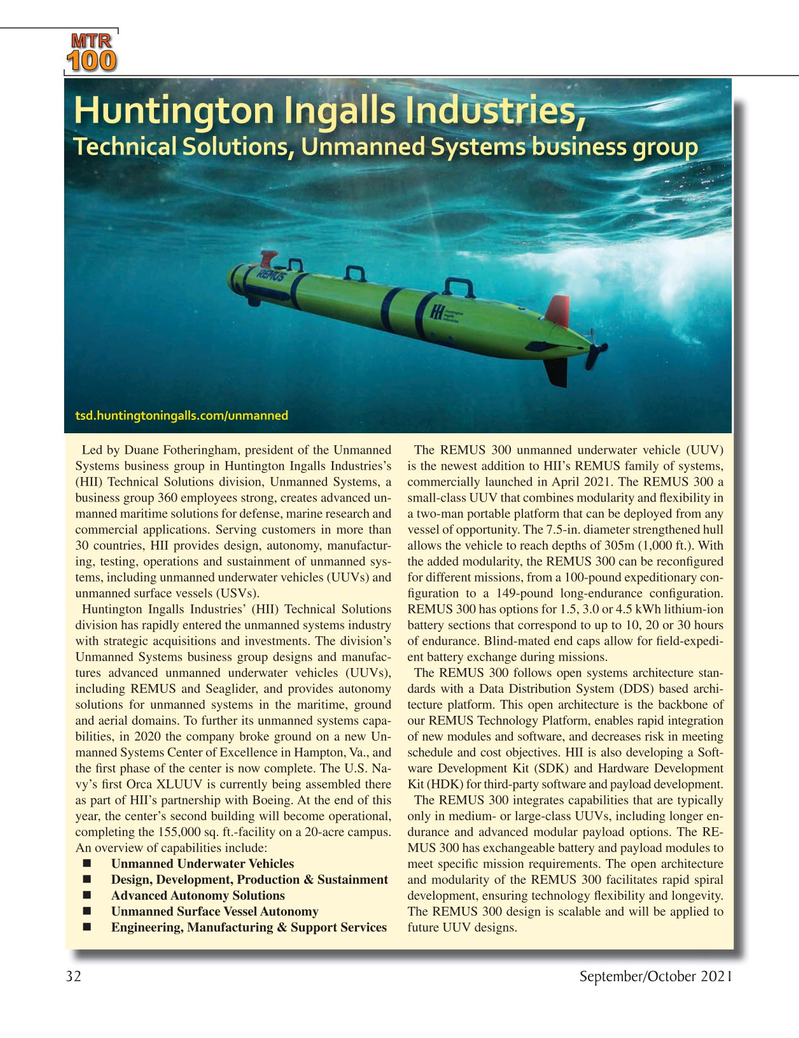
Page 32: of Marine Technology Magazine (September 2021)
MTR100: Focus on 100 Leading Companies, People and Innovations in the Subsea Space
Read this page in Pdf, Flash or Html5 edition of September 2021 Marine Technology Magazine
MTTTTTTTTTTTTTRM M M M M M M M M M M M M M M M M M M M M M M M M M M M MTRRRRRRRRRRRRRRRRRRRRRRRRRRRMTTTTTTTTTTTTTRMTR 100000000000000001111111111111111111111111111100000000000000000000000000000010000000000000000100
Huntington Ingalls Industries,
Technical Solutions, Unmanned Systems business group tsd.huntingtoningalls.com/unmanned
Led by Duane Fotheringham, president of the Unmanned The REMUS 300 unmanned underwater vehicle (UUV)
Systems business group in Huntington Ingalls Industries’s is the newest addition to HII’s REMUS family of systems, (HII) Technical Solutions division, Unmanned Systems, a commercially launched in April 2021. The REMUS 300 a business group 360 employees strong, creates advanced un- small-class UUV that combines modularity and ? exibility in manned maritime solutions for defense, marine research and a two-man portable platform that can be deployed from any commercial applications. Serving customers in more than vessel of opportunity. The 7.5-in. diameter strengthened hull 30 countries, HII provides design, autonomy, manufactur- allows the vehicle to reach depths of 305m (1,000 ft.). With ing, testing, operations and sustainment of unmanned sys- the added modularity, the REMUS 300 can be recon? gured tems, including unmanned underwater vehicles (UUVs) and for different missions, from a 100-pound expeditionary con- unmanned surface vessels (USVs). ? guration to a 149-pound long-endurance con? guration.
Huntington Ingalls Industries’ (HII) Technical Solutions REMUS 300 has options for 1.5, 3.0 or 4.5 kWh lithium-ion division has rapidly entered the unmanned systems industry battery sections that correspond to up to 10, 20 or 30 hours with strategic acquisitions and investments. The division’s of endurance. Blind-mated end caps allow for ? eld-expedi-
Unmanned Systems business group designs and manufac- ent battery exchange during missions.
tures advanced unmanned underwater vehicles (UUVs), The REMUS 300 follows open systems architecture stan- including REMUS and Seaglider, and provides autonomy dards with a Data Distribution System (DDS) based archi- solutions for unmanned systems in the maritime, ground tecture platform. This open architecture is the backbone of and aerial domains. To further its unmanned systems capa- our REMUS Technology Platform, enables rapid integration bilities, in 2020 the company broke ground on a new Un- of new modules and software, and decreases risk in meeting manned Systems Center of Excellence in Hampton, Va., and schedule and cost objectives. HII is also developing a Soft- the ? rst phase of the center is now complete. The U.S. Na- ware Development Kit (SDK) and Hardware Development vy’s ? rst Orca XLUUV is currently being assembled there Kit (HDK) for third-party software and payload development. as part of HII’s partnership with Boeing. At the end of this The REMUS 300 integrates capabilities that are typically year, the center’s second building will become operational, only in medium- or large-class UUVs, including longer en- completing the 155,000 sq. ft.-facility on a 20-acre campus. durance and advanced modular payload options. The RE-
An overview of capabilities include: MUS 300 has exchangeable battery and payload modules to ? Unmanned Underwater Vehicles meet speci? c mission requirements. The open architecture ? Design, Development, Production & Sustainment and modularity of the REMUS 300 facilitates rapid spiral ? Advanced Autonomy Solutions development, ensuring technology ? exibility and longevity. ? Unmanned Surface Vessel Autonomy The REMUS 300 design is scalable and will be applied to ? Engineering, Manufacturing & Support Services future UUV designs. 32 September/October 2021
MTR #7 (18-33).indd 32 9/21/2021 8:33:34 AM

 31
31

 33
33
